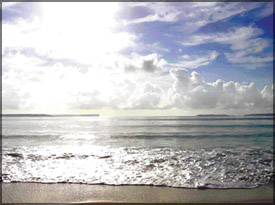Marine biome-the biggest and most fascinating
 Today,
we unfold another episode in our series on biomes, which has been
continuing for some weeks. Hope you are not bored in the journey through
the world of biomes. Today,
we unfold another episode in our series on biomes, which has been
continuing for some weeks. Hope you are not bored in the journey through
the world of biomes.
How would you like to visit the biggest and the most fascinating
biome in the world? An island nation like ours especially deals a lot
with this biome. The marine biome has the ability to fascinate anyone at
any time. You are sure to be aware of the fact that the ocean covers
about 70 per cent of the Earth. It includes five main oceans: the
Pacific, Atlantic, Indian, Arctic and Southern, as well as many smaller gulfs and bays.
Southern, as well as many smaller gulfs and bays.
We need not tell you about the saltiness of the ocean water, but did
you know that there is about one cup of salt per gallon of water in the
ocean? The ocean can be divided into three vertical zones - the top
layer known as the euphotic zone, the next layer called the disphotic
zone and the deepest part of the ocean referred to as aphotic zone or
deep sea.
The deep sea comprises 80 per cent of all the habitats on Earth,
which makes it the largest habitat on the planet. Did you know that the
deepest point in the ocean, the Mariana Trench, is deeper than the total
height of Mt. Everest? The Mariana Trench is about 36,200 feet deep.
The climate does not have much of an effect on the marine biome, but
the marine biome largely affects our global climate! It provides rain
for crops through evaporation, wind to help circulate air and affects
coastal temperatures.
The constant motion of the ocean results in currents and waves that
may either be warm or cold, depending on the weather and temperature of
that area. Temperatures in the ocean range from just around freezing at
 the
pole and in the deep waters, to tropical clear waters that are quite
warm. the
pole and in the deep waters, to tropical clear waters that are quite
warm.
The average temperature of all oceans is about 39 degrees Fahrenheit.
The heat from the sun warms only the surface of the water. Deep down,
oceans everywhere are cold and dark.
Over one million species of plants and animals have been discovered
in the oceans, and scientists say there may be as many as nine million
species we have not found yet. One reason the ocean is very important is
for all the algae in it. If it were not for marine algae, we would not
be able to breathe!
Through photosynthesis, (the process through which plants produce
food) marine plants and algae provide much of the world's oxygen supply and take in huge amounts of carbon
dioxide. This absorption of carbon dioxide may be a useful tool in
reducing the severity of climate change. One type of marine algae is
kelp. Kelp is important because it provides shelter and food for many
sea creatures.
much of the world's oxygen supply and take in huge amounts of carbon
dioxide. This absorption of carbon dioxide may be a useful tool in
reducing the severity of climate change. One type of marine algae is
kelp. Kelp is important because it provides shelter and food for many
sea creatures.
Another important marine plant is phytoplankton. These tiny plants
serve as food to many of the ocean creatures, from the smallest of fish
to large whales. Some scientists estimate that phytoplankton provide the
Earth with almost half of its oxygen! Marine plants live in the euphotic
zone of the ocean because they need energy from the sun for
photosynthesis.
The Earth's oceans are home to most of the planet's biodiversity.
Here we can find molluscs, fish, whales, crustaceans, bacteria, fungi,
sea anemones and many other animals. Animals have to deal with unique
living situations in all zones of the ocean.
 The
ocean is a salty place that is often cold. Many animals have special
adaptations to handle this difficult environment. Most marine mammals
have fat to survive in the cold water, but sea otters are unique because
they do not have fat. Instead, they have fur more dense than any other
mammal, with up to one million hairs per square inch. Most people have
ten times less than that on their heads! The
ocean is a salty place that is often cold. Many animals have special
adaptations to handle this difficult environment. Most marine mammals
have fat to survive in the cold water, but sea otters are unique because
they do not have fat. Instead, they have fur more dense than any other
mammal, with up to one million hairs per square inch. Most people have
ten times less than that on their heads!
The ocean can also support very large life forms. The blue whale is
the biggest animal on Earth. It can be over 31 metres long. Blue whales
are so large that a small person could crawl through their main
arteries, and 20 people could stand on their tongue! Animals in the deep
sea also live in a tough environment.
Compiled by Janani Amarasekara |
